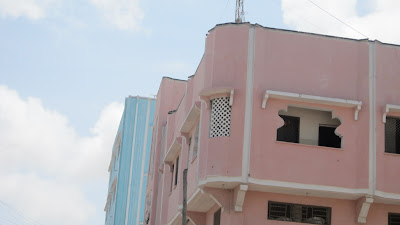This is a piece I wrote about the Catholic cathedral in the Somali capital, Mogadishu, for the BBC's From Our Own Correspondent programme which goes out on Radio Four and the World Service. It is also available here on the BBC website. I have added more pictures here so you can see what it is like.
The atmosphere changed completely when we entered the cathedral. Things fell quiet. It felt almost peaceful.
My five Somali bodyguards - wrapped in long, heavy necklaces of brass bullets - did not spring into position around me. They bent their heads towards the smashed floor of the cathedral and walked alongside me.
It was Ramadan in Mogadishu - the holy Muslim month - and we were inside the remains of what had once been one of the grandest Catholic cathedrals in the whole of Africa, built by Italian colonialists in the 1920s. Its last bishop, Salvatore Colombo, was murdered there in 1989 as he was giving mass.
I felt very tiny inside that building. Perhaps because the roof has been completely blown off, the walls of the cathedral seemed to stretch right up to the blue sky above.
Although we were in the carcass of a building, enough remained of the elegant stone arches and the shadows of crosses, for us to know that we were in a sacred place.
As I explained how the priest administered bread and wine, we looked up. High above us, carved in the stone, was Jesus on the cross. Bullet holes scarred the carving, the colours faded and gone.
During the rest of my time in Mogadishu, the guards were always hurrying me along. As a foreigner and white woman I stuck out somewhat from the crowds, and they did not want any trouble. I was a potential target, so it was not wise to stay in one place for long.
We thoroughly explored the cathedral, every corner, every side room. We glanced down into underground spaces filled with blue plastic bags, rubble and the odd bullet casing.
Suddenly, there was bit of noise and movement. A sound of giggling. Two boys - completely naked - rushed in and emptied plastic jerrycans of water onto their bodies. Scrubbing themselves as best as they could, without any soap.
They then darted into a dark corner, emerging soon afterwards dressed in clothes so old and ragged they appeared to be rotting on their bodies.
I saw such settlements, of people forced from their homes, on almost every spare patch of ground in Mogadishu. Many Somalis have lived like this for more than two decades.
As we approached an outline on the floor where the altar used to be, taking care not to step in the human excrement dotted around us, the guards started asking me how the church worked. How Christians worshiped. How exactly did they pray?
 |
| The slightly raised area is where the altar used to be |
It was very different from the streets outside where people, optimistic about the new relative stability, are opening shops, their walls freshly painted with bright images of what is on sale inside.
Livestock is a mainstay of the Somali economy, and very dear to the hearts of Somalis. The guards were unhappy that representations of animals and their saint had been so horribly damaged.
In one corner was what looked like a pile of discarded cardboard and cloth. Slowly, I made out the figure of a man, so deeply asleep he seemed not to be breathing.
During the rest of my time in Mogadishu, the guards were always hurrying me along. As a foreigner and white woman I stuck out somewhat from the crowds, and they did not want any trouble. I was a potential target, so it was not wise to stay in one place for long.
But things were different in the cathedral. We took our time. All of us seemed hypnotised by the place and found it difficult to leave.
One guard crouched down, lost in thought. Another stood still, gazing upwards past those majestic stone walls to the sky above.
We thoroughly explored the cathedral, every corner, every side room. We glanced down into underground spaces filled with blue plastic bags, rubble and the odd bullet casing.
Suddenly, there was bit of noise and movement. A sound of giggling. Two boys - completely naked - rushed in and emptied plastic jerrycans of water onto their bodies. Scrubbing themselves as best as they could, without any soap.
They then darted into a dark corner, emerging soon afterwards dressed in clothes so old and ragged they appeared to be rotting on their bodies.
Slowly and silently, an old man appeared.
"I fled here with my relatives two years ago. I came from the port of Merca, which was taken by the Islamists, by Al-Shabaab. "I wouldn't have survived under their rule," he told me. "I have no food. I have no water. The only thing I have is time."
I saw such settlements, of people forced from their homes, on almost every spare patch of ground in Mogadishu. Many Somalis have lived like this for more than two decades.
The cathedral stood in the part of town where the physical devastation was perhaps the most shocking. It is now a graveyard for what had once been the city's most grand and beautiful buildings.
I wonder if, now that things are starting to be fixed up in Mogadishu, it might be an idea to leave that cathedral how it is. As a quiet place. Somewhere for reflection. A reminder of the destruction humans can wreak.

















































































